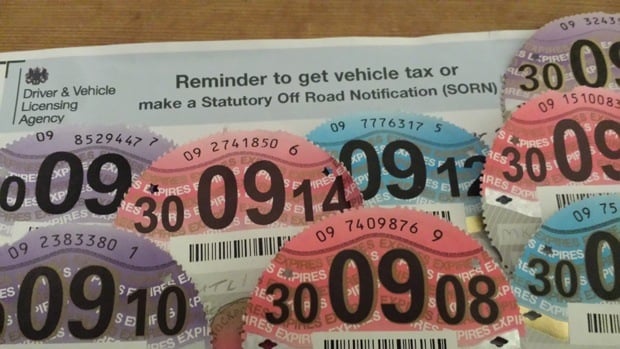
In the summer 2015 Budget Statement, the then-Chancellor George Osborne announced changes to the Road Fund Licence (RFL) to come into play in April 2017 with a change to the way it is calculated year-on-year.
According to the Government, the changes are being introduced to "make costs fairer for motorists" and apply to cars registered on or after 1 April 2017. All vehicles registered before this date will be unaffected by the changes.
The First Year Changes
The biggest change in regards to road tax is that it is no longer entirely based on the CO2 emissions of the vehicle.
In the existing road tax bandings, cars with emissions of less than 130g/km paid a lower rate of road tax but from year one from April 2017 onwards, unless the car has zero emissions, some form of road tax will need to be paid on new vehicles.
For cars with emissions of between 1 and 50g/km, this will be £10; 51-75g.km £25, 76-90 £100, 91-100 £120,101-110 £140, and 111-130 £160. Charges for cars with emissions over 130g/km have increased too, right up to those emitting 255g/km and over that now get a RFL of £2000 (up from £1120).
That's a big change, and it seems to have been initiated by the fact that car manufacturers have been reducing emissions on cars as part of a green policy.
The Second Year Changes
After the first year, ALL CARS from year 2 onwards (with the exception of zero emission cars where the standard rate will stay at zero) will be charged a standard rate of £140, with an additional charge of £310 a year (for 5 years) on any cars with an 'RFL Price List' of over £40,000 - but more about that later.
This charge after the first year is an increase to those looking for a car that emits less than 140g/km (in comparison to the previous charges) but a bonus to those with 'more polluting' cars, despite having to pay more in the first year. So does the 'fairer' statement ring true at the expense of the environment, as it seems that emissions become a less attractive consideration when looking a new car from April next year? And is it more of a benefit to drivers of bigger, and probably more expensive, cars?
Not necessarily so, because the Chancellor added in a charge of £310 a year for 5 years, starting with the second year, on cars that have an 'RFL Price List' of over £40,000 - and this is something that customers will have to really consider when buying or leasing a car.
Both the standard £140 charge and the extra charge are, of course, subject to increase in any future budgets.
To check how much tax any new car will attract, click here.
What is the ‘RFL List Price’?
This is basically the cost of the car when bought from new, and includes:
- The Manufacturer List Price including VAT as at the day before the vehicle is first registered
- The cost of any optional extras added to the car (including VAT) applicable as at the day before the vehicle is first registered (as fitted by the manufacturer). Any optional extras that are set up to be P11D exempt will NOT be exempt from the ‘RFL List Price’ calculation.
- Any delivery charges including VAT (including any pre-delivery inspection charges if that applies)
- When it comes to electric cars, these are also liable to the £310 charge (if applicable), although with zero emissions, the £140 isn't. But with these, the ‘RFL List Price’ is calculated before any OLEV grant is applied.
It does NOT INCLUDE:
- First registration fee and the cost of the first licence
- Any warranty/insurance and servicing packages
- Any optional extras already fitted by the dealer or another third party
- Any modifications such as police packs or fire engine/ambulance modifications
- Any modifications for the benefit of disabled drivers
While all this affects drivers of all cars, spare a thought for fleet managers who now have a massive headache balancing what their fleet needs against what the driver wants, because those little extras that they 'must have to do my job properly' (like heated seats and a bigger touchscreen) may take the 'RFL List Price' over the £40,000 threshold, and increase the cost of a licence. And then multiply that by the number of cars in a fleet.....
Some Examples
- Under the current rules, the Range Rover Evoque Diesel hatchback 2.0 Td4 HSE Dynamic attracts a Road Fund Licence of Zero in its first year and £110 from then on, thanks to its low CO2 emissions. Under the new rules, and registered after 1st April 2017, it will cost £160 for the first year, and £450 a year after that, as its 'RFL List Price' is £41,345. Assuming a three year car life, that's an increase in Road Tax of £840!
- The Peugeot 208 1.2 PureTech (82) Allure currently attracts a Road Fund Licence of Zero in its first year and £20 a year from then on, thanks to its low CO2 emissions of 104g/km. Under the new rules, and registered after 1st April 2017, it will cost £140 for the first year, and £140 a year after that. Assuming a three year car life, that's an increase in Road Tax of £380!
- And finally, as an example of how optional extras can cost a lot more than you think; if, after 1st April next year, a driver decided upon a BMW 5 Series Diesel Touring 520d Luxury 5Dr Step Auto with no optional extras, he would find that the 'RFL Price List' would come out as around £39,009, allowing the RFL after the first year to be £140. But the addition of extras such as metallic paint and leather seats takes the 'RFL Price List' to £40,459 (estimated), meaning that the £310 extra kicks in to give an RFL of £450 for the years after the first.
Auto Express have provided some other costing examples in this fine blog article on the road tax changes here.
Philip Nothard, retail and consumer specialist at CAP HPI, suggested to Auto Express that new and pre-registered car sales could spike ahead of next year's VED changes. "We could experience a big spike in registrations prior to the introduction of the new tax regulations, as dealers and consumers pull registrations forward on models where there is a saving, or the opposite depending on the car's current VED band."
Comment
The new rule changes will hit drivers of popular eco-friendly cars the hardest, and only time will tell if the consumer's green credentials will prove to be economic rather than ecologic, as savings on these cars start to erode.
The 2017 changes mean a car that is CO2 rated at 100g/km or lower that previously had no Road Tax for life will now cost £400 over three years, £680 over 5 years, and a whopping £1,380 over ten years. Whereas a reasonably-priced sporty model or SUV rated at 226g/km of CO2 or above could save £2,500 (against previous road tax) if you keep it for 10 years.
But it may mean a shot in the arm for electric cars with no emissions that continue to attract zero road tax.
Fairer costs for the motorist or just a money-making exercise for the Treasury? I know where my money is!
Originally posted: 1st November 2016

